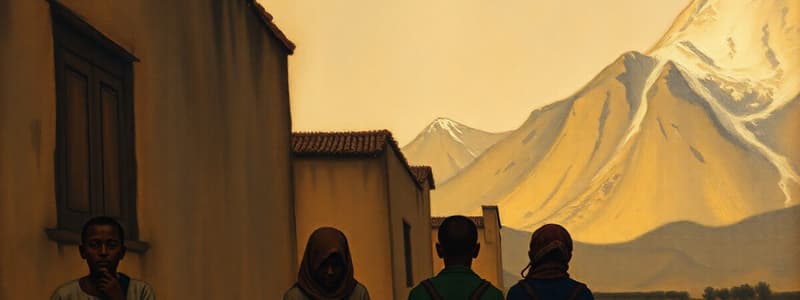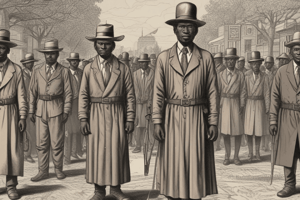Podcast
Questions and Answers
Which event directly contributed to heightened racial tensions and increased competition for resources in South Africa during the late 19th century?
Which event directly contributed to heightened racial tensions and increased competition for resources in South Africa during the late 19th century?
- The formation of the Union of South Africa in 1910.
- The abolition of slavery by the British in the 1830s.
- The enactment of the Natives Land Act of 1913.
- The discovery of diamonds and gold. (correct)
How did the Anglo-Boer War (1899-1902) influence the subsequent implementation of apartheid policies in South Africa?
How did the Anglo-Boer War (1899-1902) influence the subsequent implementation of apartheid policies in South Africa?
- It resulted in the British government implementing policies to empower black Africans.
- It prompted Afrikaners to seek the reassertion of their cultural and political dominance, setting the stage for apartheid. (correct)
- It had no significant impact on the development of apartheid.
- It led to immediate desegregation and equal rights for all South Africans.
What was the primary objective of the Natives Land Act of 1913 in the context of developing segregationist policies?
What was the primary objective of the Natives Land Act of 1913 in the context of developing segregationist policies?
- To grant black Africans ownership of all land outside urban areas.
- To promote equal land distribution among all South African citizens.
- To restrict black Africans to owning land in designated reserves, limiting their access to the majority of the country's land. (correct)
- To encourage black Africans to purchase land in white-dominated areas.
How did the National Party's political platform in 1948 directly contribute to the establishment of apartheid?
How did the National Party's political platform in 1948 directly contribute to the establishment of apartheid?
In what way did the Population Registration Act of 1950 provide a foundation for other apartheid laws and policies?
In what way did the Population Registration Act of 1950 provide a foundation for other apartheid laws and policies?
What was the intended purpose of the Group Areas Act of 1950 regarding urban and residential spaces?
What was the intended purpose of the Group Areas Act of 1950 regarding urban and residential spaces?
How did the Bantu Education Act of 1953 serve the broader goals of the apartheid regime?
How did the Bantu Education Act of 1953 serve the broader goals of the apartheid regime?
What function did the Suppression of Communism Act of 1950 serve beyond its stated aim of suppressing communism?
What function did the Suppression of Communism Act of 1950 serve beyond its stated aim of suppressing communism?
What was the primary purpose of creating 'homelands' or 'Bantustans' for black Africans under the apartheid system?
What was the primary purpose of creating 'homelands' or 'Bantustans' for black Africans under the apartheid system?
How did the pass laws function as a tool of social control and oppression under apartheid?
How did the pass laws function as a tool of social control and oppression under apartheid?
How did the Sharpeville Massacre (1960) impact the nature of resistance against apartheid?
How did the Sharpeville Massacre (1960) impact the nature of resistance against apartheid?
What role did the United Democratic Front (UDF), formed in 1983, play in resisting apartheid?
What role did the United Democratic Front (UDF), formed in 1983, play in resisting apartheid?
How did international economic sanctions influence the decline of the apartheid regime in South Africa?
How did international economic sanctions influence the decline of the apartheid regime in South Africa?
What was the significance of President F.W. de Klerk's decision to unban the ANC and release Nelson Mandela from prison in 1990?
What was the significance of President F.W. de Klerk's decision to unban the ANC and release Nelson Mandela from prison in 1990?
How did the Truth and Reconciliation Commission (TRC) contribute to South Africa's transition from apartheid to a democratic society?
How did the Truth and Reconciliation Commission (TRC) contribute to South Africa's transition from apartheid to a democratic society?
Which factor most significantly spurred the growth of Afrikaner nationalism in the first half of the 20th century?
Which factor most significantly spurred the growth of Afrikaner nationalism in the first half of the 20th century?
What was a direct consequence of the implementation of 'pass laws' on the lives of Black Africans during apartheid?
What was a direct consequence of the implementation of 'pass laws' on the lives of Black Africans during apartheid?
How did the policies implemented during the apartheid era directly lead to long-term socio-economic inequalities in South Africa?
How did the policies implemented during the apartheid era directly lead to long-term socio-economic inequalities in South Africa?
What strategic shift did the African National Congress (ANC) undertake following the Sharpeville Massacre in 1960?
What strategic shift did the African National Congress (ANC) undertake following the Sharpeville Massacre in 1960?
Which legislative action most clearly demonstrated the intent to create separate and unequal opportunities based on race during the apartheid regime?
Which legislative action most clearly demonstrated the intent to create separate and unequal opportunities based on race during the apartheid regime?
Flashcards
What was Apartheid?
What was Apartheid?
A system of institutionalized racial segregation and discrimination in South Africa from 1948 until the early 1990s.
Origins of Apartheid
Origins of Apartheid
These can be traced to early European colonization, starting with the Dutch East India Company in 1652.
Anglo-Boer War
Anglo-Boer War
An armed conflict between the British and the Afrikaners from 1899-1902 that intensified racial tensions.
Union of South Africa
Union of South Africa
Signup and view all the flashcards
Natives Land Act of 1913
Natives Land Act of 1913
Signup and view all the flashcards
Afrikaner nationalism
Afrikaner nationalism
Signup and view all the flashcards
The National Party
The National Party
Signup and view all the flashcards
Population Registration Act of 1950
Population Registration Act of 1950
Signup and view all the flashcards
Group Areas Act of 1950
Group Areas Act of 1950
Signup and view all the flashcards
Separate Amenities Act of 1953
Separate Amenities Act of 1953
Signup and view all the flashcards
Bantu Education Act of 1953
Bantu Education Act of 1953
Signup and view all the flashcards
Homelands policy
Homelands policy
Signup and view all the flashcards
Pass Laws
Pass Laws
Signup and view all the flashcards
Resistance to apartheid
Resistance to apartheid
Signup and view all the flashcards
Sharpeville Massacre in 1960
Sharpeville Massacre in 1960
Signup and view all the flashcards
Umkhonto we Sizwe
Umkhonto we Sizwe
Signup and view all the flashcards
United Democratic Front (UDF)
United Democratic Front (UDF)
Signup and view all the flashcards
F.W. de Klerk
F.W. de Klerk
Signup and view all the flashcards
Truth and Reconciliation Commission (TRC)
Truth and Reconciliation Commission (TRC)
Signup and view all the flashcards
1994 Elections
1994 Elections
Signup and view all the flashcards
Study Notes
- Apartheid was a system of institutionalized racial segregation and discrimination that existed in South Africa from 1948 until the early 1990s.
Origins of Apartheid
- The roots of apartheid can be traced back to the early periods of European colonization in South Africa, starting with the Dutch East India Company in 1652.
- Initial forms of segregation and racial discrimination were present from the beginning of colonial rule.
- The British took control of the Cape Colony in the late 18th century, and while they abolished slavery in the 1830s, discriminatory practices against non-whites persisted.
- The discovery of diamonds and gold in the late 19th century led to increased industrialization and urbanization.
- This brought diverse groups into closer contact and intensified competition for resources, further exacerbating racial tensions.
- The Anglo-Boer War (1899-1902) between the British and the Afrikaners (descendants of the Dutch settlers) had a significant impact on race relations.
- After the war, the Afrikaners sought to reassert their cultural and political dominance.
- The Union of South Africa was formed in 1910, uniting the British colonies and Boer republics.
- The South Africa Act of 1909 granted limited political rights to non-whites, but these rights were significantly curtailed over time.
- Early segregation laws were enacted in the early 20th century, such as the Mines and Works Act (1911) that reserved skilled jobs for whites.
- The Natives Land Act of 1913 restricted black Africans to owning land in designated reserves, which constituted only a small percentage of the country's total land area.
Rise of Afrikaner Nationalism
- Afrikaner nationalism grew during the first half of the 20th century, fueled by cultural, economic, and political factors.
- The National Party, led by D.F. Malan, came to power in 1948, campaigning on a platform of apartheid.
- The National Party aimed to enforce strict racial segregation and maintain white minority rule.
Legal Framework of Apartheid
- The apartheid regime enacted a series of laws to institutionalize racial segregation and discrimination.
- The Population Registration Act of 1950 classified all South Africans into racial categories: White, Black (African), Coloured (mixed race), and Asian (Indian and others).
- The Group Areas Act of 1950 designated specific areas for different racial groups, leading to forced removals of non-whites from areas classified as "white-only."
- The Separate Amenities Act of 1953 mandated the segregation of public facilities, such as restrooms, beaches, and transportation.
- The Bantu Education Act of 1953 created a separate and inferior education system for black Africans, designed to prepare them for menial jobs.
- The Suppression of Communism Act of 1950 was used to suppress political opposition, including anti-apartheid activists, by equating dissent with communism.
Implementation of Apartheid Policies
- Forced removals were a central part of the apartheid system, with millions of non-whites forcibly displaced from their homes and businesses.
- Black Africans were often moved to designated "homelands" or "Bantustans," which were nominally independent territories.
- The homelands policy was designed to strip black Africans of their South African citizenship and confine them to these impoverished areas.
- The pass laws required black Africans to carry identification documents at all times and restricted their movement into white areas.
- Restrictions on employment, education, and healthcare were imposed on non-whites, limiting their opportunities and perpetuating inequality.
- Interracial marriage and sexual relations were prohibited by law.
- Political representation for non-whites was virtually eliminated.
Resistance to Apartheid
- Resistance to apartheid took many forms, including peaceful protests, strikes, and armed struggle.
- The African National Congress (ANC), founded in 1912, initially advocated for non-violent resistance.
- The Sharpeville Massacre in 1960, in which police killed 69 peaceful protesters, marked a turning point and led to the banning of the ANC and other anti-apartheid organizations.
- The ANC, under the leadership of Nelson Mandela, turned to armed resistance, forming its military wing, Umkhonto we Sizwe.
- Other anti-apartheid groups, such as the Pan Africanist Congress (PAC), also engaged in armed struggle.
- The United Democratic Front (UDF), formed in 1983, brought together various organizations to resist apartheid through mass mobilization and civil disobedience.
- International pressure against apartheid grew over time, with economic sanctions and diplomatic isolation imposed on South Africa.
- Anti-apartheid movements around the world campaigned for the release of political prisoners and an end to racial segregation.
Decline and End of Apartheid
- By the late 1980s, the apartheid regime faced increasing internal resistance, economic problems, and international pressure.
- Negotiations between the government and the ANC began in the early 1990s.
- In 1990, President F.W. de Klerk unbanned the ANC and released Nelson Mandela from prison after 27 years.
- The repeal of apartheid legislation followed, and a new constitution was drafted to ensure equal rights for all citizens.
- The first multiracial elections were held in 1994, with Nelson Mandela elected as South Africa's first black president.
- The Truth and Reconciliation Commission (TRC) was established to investigate human rights abuses committed during the apartheid era and promote reconciliation.
Studying That Suits You
Use AI to generate personalized quizzes and flashcards to suit your learning preferences.




